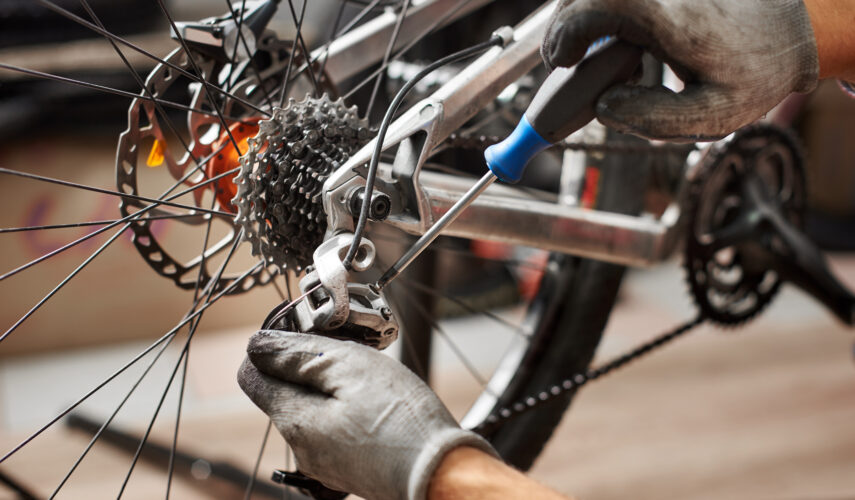When it comes to your bottom brackets, they are the hollow part at the bottom of your bike frame, they fit into your bike’s cranks and are what helps you to pedal. There’s an axle which will turn the bearings – the bearings on the right hand, the drive side and the left hand of the bike. Originally bikes were all made of steel, a material that reams and threads, with this in mind, all bottom brackets would have threads which work with the screwed chainset bearings. The bottom bracket axle was a solid steel rod and cups in the bearings created a loose ball bearing and a curved surface which would push against the ball bearings.
The bearing cups are threaded inside the bottom bracket shell and the two main standards are: BSA threaded – the shell is 68mm side to side and 33mm in diameter, or Italian threaded – the shell width is 70mm and diameter is 34mm.
You’ll still see inboard bearings on many bikes, they often include a solid square taper axle. If you have a really old bike, then the cranks may be connected to the axle with a bolted-on transverse cotter pin. Track bikes tend to have inboard bearings with an Octalink that is connected to the cranks.
There are some issues surrounding this that include, if the steel is heavy and if the bearings are too close together there will be a lot of free axle at both sides of the bottom bracket shell. This will result in loss of rigidity and pedalling efficiency. Carbon fibre is also an option and this doesn’t suit having threads cut into it. So when it comes to bottom bracket standards, there tends to be three main problem areas.
The two solutions to helping to improve bottom bracket lightness, compatibility and stiffness in carbon frames is using the same 68 width shell but the bearings need to be placed further apart or the shell needs to be much bigger.
The trend tends to be longer axles that have a bigger diameter, to get the bearings further apart you need to increase the stiffness and power transfer, this can make the frame more substantial, a larger diameter axle can be made with hollow axles and thinner walls. Overall these will be much lighter and stiffer.,
It’s also important to consider the Q-Factor, this will be the distance between the outside edges of the two crank arms, there will be a perfect spot for this – a spot where pedalling will be the most efficient. If bottom brackets are too wide, it might be like trying to pedal a horse, if it’s too narrow, then you may notice the power drop off.
External Bearings
When it comes to external threaded bearings, Shimano was an early advocate of moving the bearings from outside the bottom bracket shell. This is a common solution that can increase the distance between the bearings, this is to provide extra rigidity and continue the use of the threads in the steel and alloy bottom bracket shells.
The axle diameter can be increased to 24mm, this will increase axle stiffness, the axle will be hollow which reduces the weight. Bearings tend to be housed in sealed races, this will make them easy to both remove or replace. There will be a solid interface between the frame and the bearings which will eliminate creaking.
As well as Shimano, sealed external bearings will be available in SRAM and Campagnolo, although these 24mm external bearings can be compatible for different solutions.
Press Fit Bearings
With the increase in the use of carbon fibre frames, threaded bottom brackets can be a problem. As you can’t easily cut a thread into carbon, so manufacturers will include a metal piece into the bottom bracket shell to screw in the bearings, this will add more weight.
Cannondale promoted the BB30 system, this is a solution that can be adopted by manufacturers and rather than screwing in, the bearings will be pushed into the carbon bottom bracket shell through a thread press, similar to headset bearings. A special adapter can be used to fit the bearings and will ensure that they are parallel, there will be a circlip inside the shell on the side and this will make sure that the bearings stay in the right position.
The axle diameter will be increased from 24mm to 30mm, this means that it will be lighter without losing rigidity and even though the shell width is still 68mm. By having the bearings inboard in the shell, this will mean that there’ll be extra room for wider frame tubes and this will allow bikes to use more frame rigidity for efficiency pedalling.
Press Fit bearings will be widely used on a number of modern carbon frames, the BB30 standard will need close tolerance from the frame, this is to make sure that the bearings will fit without play. Early BB30 frames are known for their creaky bearings.
You can check out the large range of bottom bracket bearings, including NTN bearings that we have available here at Aire Velo Bearings.

